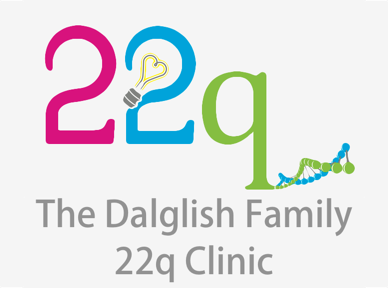Diagnosis and Management
There are many possible symptoms associated with 22q11.2DS. Most individuals only have some of these possible features. There is no established correlation between the extent of the deletion and the clinical features. The presence of one symptom does not predict the presence of any other feature.
Individuals can be diagnosed at any stage of their lives:
- Those with cardiac anomalies or severe feeding problems tend to be diagnosed in infancy
- Those with less severe and/or less typical congenital abnormalities or who were children before genetic testing became available may be diagnosed later in life or may not be diagnosed at all
- Each individual requires a tailored approach to management of 22q11.2DS and the accompanying health problems
- We recommend that all individuals with 22q11.2DS receive routine assessment at a specialty clinic, where possible.
- It is often useful to anticipate and proactively deal with health and other issues associated with 22q11.2DS
Health concerns may change with age:
- As young people with 22q11.2DS approach adulthood, the focus usually switches from mainly physical and developmental issues to psychiatric, social, and employment challenges
Please refer to the Updated clinical practice recommendations for managing adults with 22q11.2 deletion syndrome (2023) for more information.
Differential diagnosis
The following are some syndromes in which the symptoms partially overlap those of 22q11.2DS:
- CHARGE (Coloboma-heart-atresia-retarded-genital-ear) syndrome
- Kabuki syndrome
- Smith-Lemli-Opitz syndrome
- Goldenhar (Oculo-auriculo-vertebral) syndrome
- Alagille syndrome
- VACTERL association
In addition:
- Each of the symptoms associated with 22q11.2 deletion syndrome can be found as an isolated anomaly in an individual without 22q.11.2DS.
- Individuals who have no deletions at 22q11.2 may have detectable chromosomal changes at other genomic locations. e.g. 15q13.3, 1q21.1
Benefits of having a definitive diagnosis for teenagers and adults
Source: Caregiver and adult patient perspectives on the importance of a diagnosis of 22q11.2 deletion syndrome. Costain G, Chow EW, Ray PN, Bassett AS. J Intellect Disabil Res. 56(6):641-51, 2012
- Recognition and intervention for treatable problems that have been mild or hidden. These issues may include, but are not limited to:
- cardiac anomalies
- psychiatric illnesses
- learning disabilities
- Minimization of complications and resultant costs of treatment
- Achievement of greater understanding and certainty of oneself or affected family members
- Gain of a sense of purpose and a platform for advocacy
- Obtainment of reproductive counselling
- Assessment for possible familial cases
- Participation in appropriate educational and social support networks
Growth charts specific to individuals with 22q11.2 deletions
Great Ormond Street Hospital for Children London (GOSH), and Children’s Hospital of Philadelphia (CHOP) have produced five centile (9th, 25th, 50th, 75th, 91st) lines for weight, height, body mass index (BMI) and head circumference of Caucasian subjects. Please see Syndrome-specific growth charts for 22q11.2 deletion syndrome in Caucasian children for details. For colour versions of the growth charts, please visit the website of the 22q Foundation.
Life expectancy
Source: All-cause mortality and survival in adults with 22q11.2 deletion syndrome Van L, Heung T, Graffi J, Ng E, Malecki S, Van Mil S, Boot E, Corral M, Chow EWC, Hodgkinson KA, Silversides C, Bassett AS. Genet Med. 21(10):2328-2335, 2019.
| With congenital heart disease | No congenital heart disease | |
|---|---|---|
| Live to at least 40 years old | 82% | 98% |
| Live to at least 50 years old | 63% | 85% |
The most likely causes of death found in the study were sudden cardiac death and heart failure. Other causes include arrhythmia, cancer, stroke, pneumonia, septic shock, and suicide.
Options for prospective parents
Pre-conception options for prospective parents include:
- In vitro fertilization + pre-implantation genetic diagnosis
- Use of donor egg or donor sperm
- Adoption
Pre-natal testing methods include:
- Ultrasound scanning and fetal electrocardiogram
- Non-invasive but cannot detect all the congenital anomalies associated with 22q11.2DS
- Deletion testing via amniocentesis or chorionic villus sampling
- Invasive but accurate
For more information, please visit:
- our section on Genetic counselling and the testing of family members
- Prenatal screening and diagnostic considerations for 22q11.2 microdeletions (2023)
Some individuals with 22q11.2DS have learning difficulties and may not fully understand the risks and benefits of the choices they make. Physicians are advised to take these weaknesses into account during reproductive counselling of the individuals.
